Crystal Show Pieces: A Comprehensive Analysis


Intro
In the world of decorative arts, crystal show pieces stand as a testament to human creativity and craftsmanship. They are not merely objects, but embodiments of culture and history, capturing the eyes of enthusiasts and collectors alike. As we embark on this exploration of crystal show pieces, we will dive into their aesthetic appeal, rich history, and the myriad of factors that contribute to their value. This journey shall equip you with the insights necessary to appreciate these exquisite items.
Gemstone Overview
Definition of Gemstones
Gemstones, by their very nature, are minerals that possess beauty, rarity, and durability. When one thinks of gemstones, one might envision precious stones like diamonds or emeralds, but the scope is much broader. Crystals can vary in size, color, and clarity, allowing a singular gem to tell countless stories and reveal a variety of meanings. The simple act of holding a gemstone can evoke emotions that go beyond its fiscal value.
Classification of Gemstones
Generally, gemstones are classified into two main categories: precious gemstones and semi-precious gemstones. However, this bifurcation is more nuanced than it sounds.
- Precious Gemstones: These include diamonds, rubies, sapphires, and emeralds, often celebrated for their historical significance and vibrant hues.
- Semi-Precious Gemstones: While not lesser in beauty, stones like amethyst, turquoise, and garnet fall into this category due to factors such as availability and desirability.
"The value of a gemstone isn’t just found in its physical attributes; it also lies in its meaning and the stories it tells.”
Crystals used in show pieces are carefully selected for their clarity and iridescence. Factors such as the source and treatment of the gemstone can significantly influence the final piece and, ultimately, the collector's interest.
Historical Significance
Origins of Gemstone Use
The use of gemstones in human culture dates back thousands of years. From ancient Egyptians adorning their tombs with lapis lazuli to Greeks carving intricate jewelry from agate, these stones played a vital role in various civilizations. They were often used as talismans, believed to confer protection or power upon their bearers.
Cultural Insights: Gemstones in Ancient Civilizations
Several civilizations have held gemstones in high esteem:
- Egypt: Gemstones were not only decorative but were seen as symbols of divine connection.
- India: The rich history of gemstones in Indian culture is steeped in spirituality and mythology, where they were imbued with significant astrological meanings.
- China: The Chinese have revered jade for centuries, associating it with purity and moral integrity.
These historical contexts enrich the story behind crystals, making them more than just beautiful showpieces. They carry values, beliefs, and traditions that continue to echo through time, capturing the imagination of collectors today.
As we navigate through the subsequent sections, we will delve deeper into the craftsmanship and nuances associated with crystal show pieces, enhancing our understanding of their allure.
Prologue to Crystal Show Pieces
The realm of crystal show pieces invokes a unique blend of artistry, craftsmanship, and historical legacies. These sparkling creations are not merely decorative items; they stand as monuments to skilled artisanship and cultural narratives spanning centuries. From ancient royal courts to modern-day homes, the allure of crystal has captured the imagination and admiration of many.
Crystal show pieces are more than just beautiful objects; they're conversation starters, family heirlooms, and investment opportunities. Understanding what these items represent can greatly enhance one's appreciation of them, whether for personal enjoyment or as part of a collection.
Defining Crystal Show Pieces
At its core, a crystal show piece refers to a decorative object made from crystal or glass that is primarily designed to catch the eye and showcase the artist's talent. These pieces can range from intricately carved sculptures to elegantly simple vases. They often boast optical qualities, which can refract light in mesmerizing ways, adding a dynamic element to static forms.
In terms of material, crystal is traditionally considered to be glass that has been enriched with lead oxide or potassium oxide. This process enhances its sheen and light-bending abilities, setting it apart from regular glass. However, not all crystal show pieces are created equal; factors such as clarity, weight, and craftsmanship play a significant role in defining the quality of these gleaming treasures.
The Allure of Crystals in Decorative Arts
Crystals resonate with beauty in a way that few materials can. Their ability to shimmer and sparkle draws people in, captivating the viewer's attention. The allure of crystals in decorative arts is multifaceted. For one, different cultures have imbued these objects with various meanings throughout history. In some societies, crystals symbolize wealth and status, while in others, they represent purity and clarity of spirit.
Moreover, the role of crystals has evolved from ceremonial and spiritual objects to modern-day decor staples. Decorating with crystal isn't just a aesthetic choice; it's a way to invite a sense of elegance and sophistication into a space.
- Crystals in home decor are often used to emphasize natural light, transforming an ordinary room into a radiant paradise.
- Collectors value not only the beauty but also the storied histories behind each piece, making them treasures worth safeguarding.
"The beauty of crystal show pieces lies not just in their form, but in the narratives and traditions they carry with them."
In summary, understanding crystal show pieces involves appreciating their definitions, significance in various cultures, and the sheer visual delight they provide. As we delve deeper into the world of these fascinating artifacts, we’ll explore their history, craftsmanship, and the emotions they evoke.
Historical Context
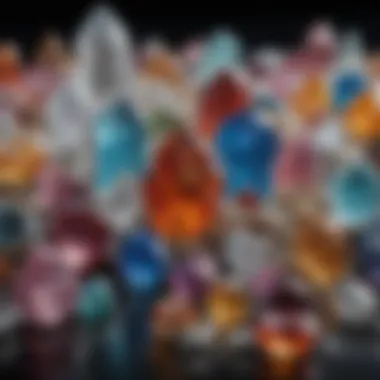
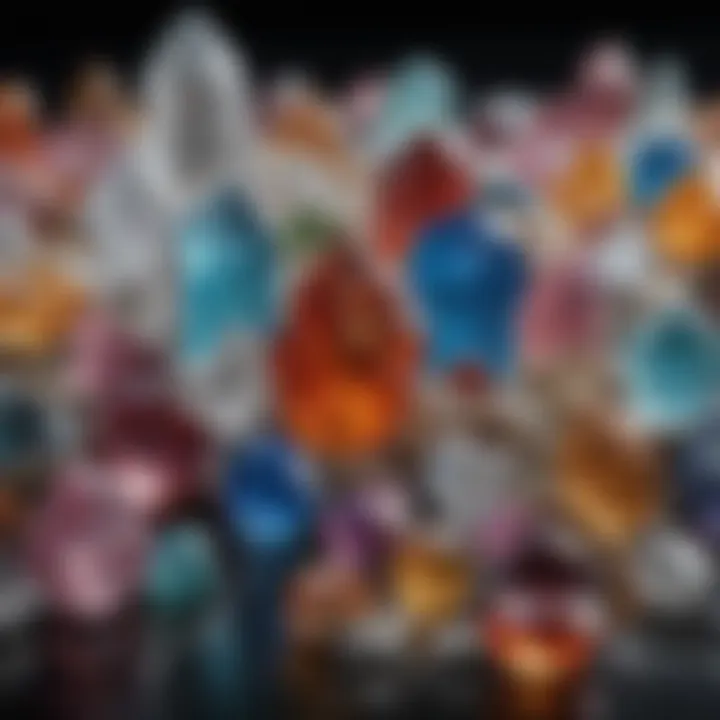
Understanding the historical context of crystal show pieces enhances our appreciation for these exquisite artifacts. The journey of crystal through time, from ancient rituals to modern-day displays, is not just a tale of materials and aesthetics. It reflects a tapestry of human experience, cultural significance, and evolving artistic expression. An examination of this context reveals why crystals have transcended mere decoration, becoming symbols intertwined with identity and status across societies.
Origins of Crystal Artifacts
The history of crystal artifacts can be traced back thousands of years. Ancient Egyptians, for instance, utilized lapis lazuli and quartz for their intricate jewelry and ceremonial objects, believing these stones possessed divine powers. Crystals were not merely decorative back then; they were often embedded with spiritual significance, serving to connect the physical world with the divine.
As civilizations flourished, so too did the use of crystals. In ancient Greece, clear quartz was likened to the ice of the gods, revered for its clarity and beauty. The Greeks claimed it represented eternity, a belief that resonates through time—even today, many see the brilliance of crystal as an expression of timeless beauty.
The Romans, not to be outdone, popularized the use of amethyst and other semi-precious stones, signifying wealth and power. These crystals evolved into status symbols, adorning everything from rings to elaborate show pieces, showcasing not just personal affluence but also craftsmanship that has endured through the ages.
"In the hands of skilled artisans, stone becomes more than a material; it transforms into an echo of cultural legacy, resonating through centuries."
Cultural Significance Across Civilizations
Crystals have always held a prominent place in various cultures around the globe. For instance, in many Eastern philosophies, crystals are often seen as conduits of spiritual energy. Cultures like the Chinese have long incorporated crystal energy into practices such as feng shui. The placement of crystals is believed to guide energy flow in spaces, enhancing harmony and balance.
In indigenous cultures, stones like obsidian and turquoise play essential roles in rituals and healthcare, viewed not merely as tools but as protectors and carriers of ancestral spirits. This highlights that crystals often symbolize more than beauty; they serve roles as bearers of tradition and cultural narratives.
Conversely, the European Renaissance saw a surge in crystal craftsmanship, where artists began to fuse artistry with science. This period was marked by an interest in natural history, stimulating the creation of ornamental pieces that echoed the natural world's wonders. Their significance evolved as crystals began to bridge the gap between art and science, enriching collections across Europe, especially among nobility.
In many modern contexts, crystal show pieces have retained their luxurious associations while adapting to contemporary designs. As such, these artifacts continue to attract collectors and enthusiasts, symbolizing a conversation that spans ages and cultures.
Thus, the historical journey of crystal artifacts is a testament to their enduring appeal. They encapsulate humanity's connection to nature, spirituality, and artistry, creating a legacy that invites continued appreciation and exploration.
Employing crystals in display at home, or as cherished possessions, isn’t merely about the stone's beauty. It’s a thoughtful engagement with the echoes of history, allowing us to partake in the cultural significance carried within each piece.
Types of Crystals Used in Show Pieces
Understanding the types of crystals employed in crafting show pieces is pivotal to grasping their beauty, appeal, and unique characteristics. Each crystal brings its own story, properties, and allure. Collectors and enthusiasts alike may find themselves enchanted not just by the aesthetic usability but also by the metaphysical qualities these stones are often attributed to. Furthermore, knowing the specific elements and attributes of different crystals can vastly increase the appreciation for these intricate works of art.
Common Crystals and Their Properties
When stepping into the world of crystal show pieces, certain crystals dominate the landscape due to their unparalleled beauty and availability:
- Crystal Quartz: This clear, transparent crystal is a staple in many collections. Known for its versatility, crystal quartz is thought to amplify energy and thought. Its clarity mesmerizes onlookers and adds a shimmering finish to any display.
- Amethyst: Valued for its stunning purple hue, amethyst is more than just eye-catching. It's often associated with calm and healing properties. A show piece crafted from amethyst serves dual purposes of enhancing decor and purporting serenity within the space.
- Swarovski Crystals: Renowned for their precision cutting, Swarovski crystals often grace luxury items with their unmatched sparkle. While man-made, their brilliance has captured the hearts of many and makes them a popular choice for modern show pieces.
- Smoky Quartz: This unique brownish-grey crystal engenders feelings of grounding and protection. It blends seamlessly into many decors, bringing a touch of elegance while invoking nature's steadfast roots.
Why Knowing Common Crystals Matters: Identifying and understanding these common crystals offer collectors insights into pricing, authenticity, and overall maintenance. Not only are they aesthetically pleasing, but knowing their properties helps aficionados make well-informed choices about which pieces to add to their collections.
Rare Crystals: Origins and Characteristics
While common crystals hold a significant place in the market, the rarest specimens can drum up both excitement and envy among collectors. Here’s a look at some of the rare gems that truly stand apart:
- Benitoite: Originating primarily from California, this rare blue gemstone is not only striking but carries a high market value. Its strikingly unique color makes it a rare collector's gem and adds sizeable worth to any show piece.
- Red Beryl: A cousin of emerald and aquamarine, red beryl is exceptionally hard to find. Its vibrant red hues can be a centerpiece in any collection. The origins of this crystal can be traced back to the western United States, making it local yet extraordinarily rare.
- Musgravite: Once mistaken for spinel, musgravite is hard to come by and often eludes collectors. Its colors range from greyish to greenish, giving it a subtle yet sophisticated elegance. Originating from Australia and Madagascar, rare finds in this crystal can draw bids in auction houses that leave one breathless.
- Painite: Once listed in the Guinness World Records as one of the rarest minerals on Earth, painite is truly a gem to be coveted. Ranging in shades of brown to reddish-brown, owning a painite show piece could elevate any collection.
Understanding the origins and characteristics of these rare crystals enhances not only the monetary value of a show piece but also the historical and cultural significance it carries. These gems often come with stories that deepen their appeal.
"In the world of crystal collectibles, rarity often trumps beauty. Owning a rare piece is akin to holding a whisper of Earth's history in your hands."
Whether you find solace in the common or chase the elusive rare crystals, knowing their stories and attributes will serve to enrich the experience of any crystal devotee. Delving deeper into this subject not only caters to an individual’s aesthetic tastes but also builds a rich tapestry of knowledge, appreciation, and connection with the world of crystals.
Craftsmanship and Artistic Techniques
The craftsmanship and artistic techniques employed in creating crystal show pieces are vital parts of their allure and value. These elements not only reflect the skill and creativity of the artisans but also determine the final aesthetic and practical qualities of the pieces. Every gemstone tells a story, and how it is cut, polished, and arranged speaks volumes about the traditions and innovations that underpin crystal artistry. It is within the precise hands of skilled artisans that raw materials are transformed into magnificent works of art.
Traditional Techniques in Crystal Carving
Traditional techniques in crystal carving have stood the test of time, steeped in centuries of history. Techniques like faceting, engraving, and polishing are employed to enhance the natural beauty of crystals such as quartz and amethyst.
- Faceting involves cutting the crystal into flat surfaces to enhance its light reflection, creating a stunning sparkle that draws the eye without fail.
- Engraving is a more intricate approach, where artisans skillfully incise designs into the surface, often resulting in delicate motifs and patterns. Each stroke carries the weight of tradition, often inspired by cultural symbols.
- Polishing is the final touch, where a final shine is achieved using tools and techniques passed down through generations. This not only brings out the brilliance of the crystal but also ensures that the piece will endure through time.
These labor-intensive methods require not just technical skills but also an artist's eye for detail and a deep connection to the material being worked on. The end product often becomes a celebration of heritage and craftsmanship that resonates with collectors.
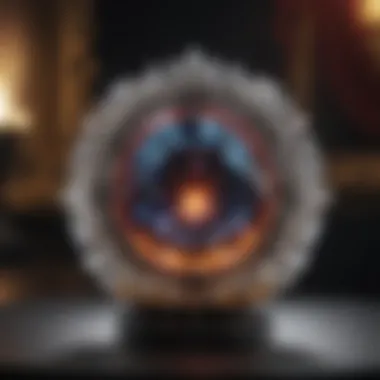
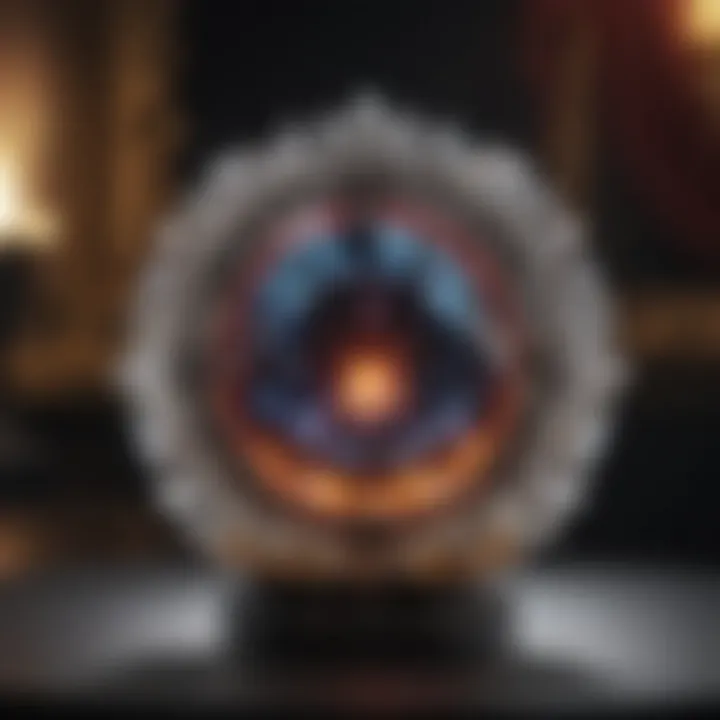
Modern Innovations in Crystal Design
In contrast, the landscape of crystal craftsmanship has not remained static. Modern innovations have paved the way for new designs, materials, and techniques that redefine what can be done with crystals. Advances in technology have played a pivotal role.
- Laser cutting allows for precision that was once unimaginable, enabling intricate patterns and designs that can breathe new life into traditional shapes. This technology enhances efficiency while maintaining a high level of artistry.
- 3D printing has opened up avenues for experimentation, allowing designers to prototype and create forms that defy conventional methods. This technology can yield complex geometries that captivate the eye, offering fresh perspectives on crystal art.
- Innovative combinations of crystals with other materials, such as metal and glass, can produce striking contrasts, making each piece not just a decorative item but also a statement of creativity.
These modern approaches reflect a broader trend in the decorative arts that embraces experimentation while respecting the inherent beauty of crystals. They provide thrilling opportunities for both artisans and collectors, expanding the limits of design and craftsmanship.
The Role of Artisans in Crystal Creations
Artisans are the heart and soul of crystal show piece creation. They are not merely workers with tools; they are visionaries who breathe life into dormant materials. The artisan's role spans various aspects of the craft, from initial concept to final execution.
- Skill Development: Many artisans undertake years of apprenticeships, learning techniques from masters of the craft. This knowledge is invaluable, ensuring that age-old practices continue to thrive alongside new innovations.
- Creativity and Vision: An artisan's imagination drives their work. Each piece is a personal expression that often encapsulates narratives drawn from their own experiences or cultural backgrounds.
- Market Influence: The unique touch of an artisan can significantly influence a piece’s market value. Collectors often seek out works from specific artisans, elevating the demand for their creations and consequently enabling them to command higher prices.
As the demand for unique, handcrafted pieces continues to rise, artisans remain at the forefront, bridging the gap between traditional techniques and modern designs.
"The beauty of a crystal show piece lies not only in its appearance but also in the skilled hands that shaped it and the story it tells."
Through mastery of these techniques and unwavering dedication, artisans assure that crystal show pieces are not mere decorative items but cherished tokens of human creativity.
Market Trends and Valuation
Understanding the market trends and valuation of crystal show pieces is essential for collectors and enthusiasts alike. This section focuses on the various market dynamics that influence the desirability and price of these exquisite items. Identifying trends enables buyers and sellers to make informed decisions, with a clear picture of what drives value in the world of crystals.
Understanding the Market Dynamics
The market for crystal show pieces is constantly evolving, with several factors playing a pivotal role. Trends may emerge from fashion cycles, cultural shifts, or advancements in technology. For instance, more than ever, consumers seek sustainability. Crystals that are ethically sourced and environmentally friendly tend to attract a premium. This is not just a passing phase; it reflects a growing awareness within the community about the impacts of mining and global trade practices.
Market conditions can also fluctuate based on collector sentiment. For example, a sudden spike in interest for vintage crystal pieces from the 18th century can elevate their prices overnight. Meanwhile, social media has opened new avenues for marketing, allowing unique crystals to gain visibility quickly. Platforms such as Facebook groups and Reddit forums facilitate discussions where collectors share insights and trends, further influencing what crystals become sought after.
"A crystal's value often lies not just in its material but in its story and provenance."
Factors Influencing the Value of Show Pieces
When assessing the worth of crystal show pieces, various elements come into play. Factors can broadly be categorized into intrinsic and extrinsic values:
- Intrinsic Value:
- Extrinsic Value:
- Quality of Material: The type of crystal can make a significant difference. High-quality quartz or rare gemstones generally fetch higher prices.
- Craftsmanship: Artisanship plays a key role. Show pieces that exhibit exceptional techniques or unique designs usually stand out.
- Condition: Like any collectible, the state of preservation is vital. Flaws or damage can greatly diminish value.
- Market Demand: If a particular style suddenly becomes trendy, expect prices to soar. Trends change, and what might be valuable today could lose its luster tomorrow.
- Cultural Significance: Crystals associated with certain cultures or historical events can intensify their appeal. An example is the resurgence of interest in African crystals during global introspection towards cultural diversity.
- Rarity: As with any collectible market, scarcity can drive up prices. Limited edition pieces or those from discontinued collections often see increased value.
In order to navigate this dynamic landscape, maintaining a keen awareness of these factors is crucial. Those who wish to engage seriously in buying or selling crystal show pieces should do their homework, analyze market trends, and always consider the story behind each piece.
Care and Maintenance of Crystal Show Pieces
Taking care of crystal show pieces is not just about keeping them clean. It revolves around preserving their beauty and ensuring that they last for generations. The mesmerizing brilliance of crystal can fade if neglected, which is a thought that leaves many collectors uneasy. Proper care is paramount—it adds years to the lifespan of these exquisite pieces, enhances their aesthetic appeal, and significantly maintains their market value.
In this segment, we will discuss effective cleaning techniques and storage solutions that respect the delicate nature of crystals and ensure their integrity over time.
Cleaning Techniques and Recommendations
Cleaning crystal show pieces is a task that requires both gentleness and proper technique. They are often more fragile than they appear, so knowing how to handle them with care is essential. To start on the right foot, here are some systematic approaches:
- Dust Regularly: Use a soft, lint-free cloth—microfiber works wonders. Dust can accumulate and dull the sparkle, so making this a habit is beneficial.
- Use Mild Solutions: When deeper cleaning is necessary, prepare a solution of warm water and mild soap. Dip the cloth in the solution, wring it out, and wipe your crystal gently. Avoid submerging them in water, as moisture can seep into delicate seams.
- Rinse Thoroughly: After cleaning, rinse with lukewarm water to remove any soap residue. Again, don't immerse; just use a damp cloth.
- Dry with Care: Pat your pieces dry using soft towels or cloths. Harsh plates or paper towels might scratch the surface. Alternatively, allow them to air dry in a secure location, out of direct sunlight to prevent discoloration.
Regular maintenance not only preserves the beauty of crystal but also fortifies its longevity. Don’t let neglect turn your cherished pieces into mere relics of the past.
Storage Solutions to Preserve Integrity
When it comes to storage, ensuring that your favorite crystal pieces hold their regal luster relies on choosing the right environment. Here are some thoughtful considerations:
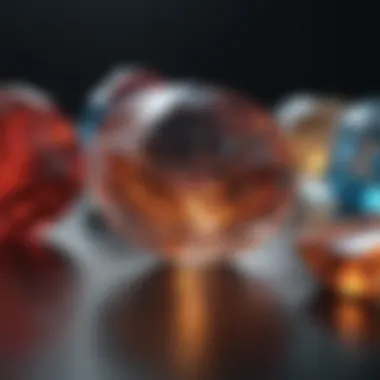
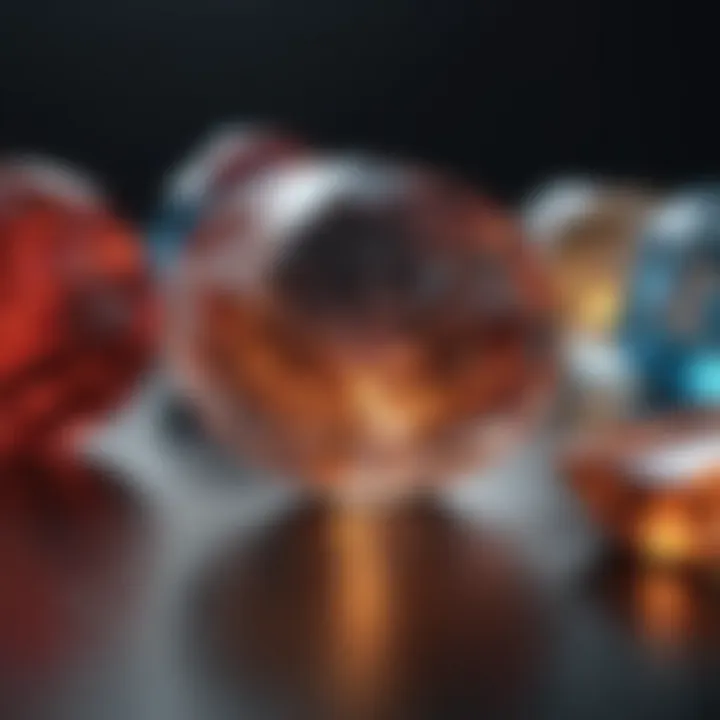
- Display Wisely: Place your show pieces in well-ventilated areas away from direct sunlight, as strong rays can lead to fading or potentially affect the color of the crystals.
- Use Protective Containers: When not on full display, consider using cushioned boxes or display cabinets. These should be lined with soft fabric to further reduce any risks of scratching.
- Avoid Clutter: Don’t crowd them together; giving crystals enough space prevents chipping or breaking when they're in contact with other objects. Remember, earthquakes or even minor shake-ups can happen unexpectedly.
- Temperature Control: Make sure they are stored in a climate-controlled room. Sudden temperature shifts can cause materials to expand and contract, leading to cracks over time.
Remember, the life of your crystal pieces lies in your hands—educated choices about cleaning and storing can make all the difference. The attention you provide today could be what make future generations appreciate their beauty long after you’re gone.
Integrating Crystal Show Pieces into Decor
Integrating crystal show pieces into existing décor can elevate a space in ways that mere paint or common furnishings simply can’t match. When carefully incorporated, these stunning artifacts become focal points, sparking conversations and drawing admiration. Crystal's inherent beauty, along with its refractive properties, captures light and transforms it into a visual treat, which can create an ambiance that appeals to both eye and emotion.
Artfully placing crystal show pieces involves understanding the space and the mood one seeks to create. Here are some key elements and benefits to consider when aiming to blend these exquisite items into home décor:
- Visual Appeal: Crystals possess a unique sparkle that can brighten up even the dullest of rooms. Their transparency allows them to reflect light in intricate patterns, lending an ethereal quality that is hard to replicate with other materials.
- Versatility: Crystals can fit into various design styles—from modern minimalist to traditional elegance. They come in diverse shapes and sizes, which means they can suit almost any furniture arrangement.
- Symbolic Value: Many crystal collectors believe that each piece carries a unique energy or meaning. Integrating them into a living space can help to create an environment that aligns with personal values or aspirations.
Design Principles for Displaying Crystals
When it comes to showcasing crystal show pieces, design principles play a vital role in ensuring that they are presented to their full potential. Here are some practical guidelines:
- Highlighting Focal Points: Select a prominent location where crystals can shine undisturbed. A well-placed stand or shelf can pull the eye naturally towards these gems.
- Layering and Grouping: Instead of placing a single piece amidst a sea of clutter, consider grouping smaller crystals or combining them with complementary decor items. This can enhance their visual importance.
- Balancing Surroundings: Be sure not to overshadow the crystals with overly busy designs or colors. They thrive best in surroundings that allow their natural beauty to be the star player.
"A well-placed crystal can transform a room, illuminating not just the space, but also the spirit of those who inhabit it."
Creating Harmonious Spaces with Crystals
In fostering a harmonious environment, crystals can serve as essential components of well-designed spaces. Here are some aspects that can help in aligning crystal decor with overall home aesthetics:
- Color Coordination: Pay attention to the hues present in crystal pieces and the surrounding decor. Crystals in soft tones, like rose quartz, can offer a gentle, calming vibe, while vibrant amethyst might provide an invigorating effect.
- Natural Elements: Incorporating plants or wood alongside crystal show pieces can enhance the organic feel of the space. It creates a contrast that brings out the natural elegance in both crystals and flora.
- Mindfulness in Arrangement: Consider spatial design and flow. Each piece should feel intentional, inviting one to pause and appreciate its beauty.
When combined thoughtfully, crystal show pieces can amplify the emotional and aesthetic resonance of a space. They are not just for show; they can infuse a home with memory, intention, and beauty.
The Psychological and Emotional Impact of Crystals
Understanding the psychological and emotional impact of crystals is key to grasping their allure and significance in contemporary culture. Crystals are not merely decorative items that sit on shelves; they often hold deeper emotional meanings and metaphysical beliefs for many individuals. Their presence is felt in various settings—from personal spaces to communal ones—creating an atmosphere that resonates with the emotional and psychological states of those who behold them.
Metaphysical Beliefs Surrounding Crystals
Across cultures and throughout history, crystals have been deeply rooted in metaphysical beliefs. Some folks view crystals as conduits for energy, believing that different types of crystals emit distinct vibrations that can influence emotions and thoughts. For instance, amethyst is often associated with calming properties, while citrine is linked to prosperity and motivation. This belief underscores the notion that crystals can aid in balance and healing if used mindfully.
Consider how lapis lazuli, often heralded for its ability to enhance communication, might be placed on a desk during significant discussions or negotiations. Users often feel empowered by this symbolism, which can transcend mere decoration; it becomes a tool for personal development and emotional well-being.
"Crystals serve as a reminder of the energies we want to attract into our lives."
This persistent notion of positive energy projection often encourages individuals to engage with crystals actively, thereby integrating them into daily routines. Workshops and guided sessions often emphasize the rituals surrounding crystal use, such as cleansing and setting intentions, fostering a deeper connection to these brilliant formations.
Personal Connections to Crystal Show Pieces
On a personal level, the connection individuals form with crystal show pieces can be profound. Whether it's a piece inherited from a grandmother or a striking quartz sculpture acquired during travels, these items often hold cherished memories. They can become symbols of milestones, aspirations, or healing journeys.
When a person chooses a crystal, they're often selecting something that resonates with them on a deeper emotional level. It could be the stunning sparkle of a Swarovski glass figurine or the captivating blue hue of aqua aura quartz—these objects can evoke feelings of joy, nostalgia, or comfort. Experiencing these emotional responses can significantly enhance personal spaces, making them feel more curated and thoughtful.
Having discussions with other enthusiasts on platforms like Reddit often leads to revelations about how these relationships with crystals transcend mere materialism. They become integral to one’s identity, serving not just as decoration but as objects imbued with personal significance and history.
In sum, the psychological and emotional impact of crystals speaks to their multifaceted nature. For many, these shimmering pieces are not just aesthetically pleasing; they are emblematic of broader beliefs and personal stories, intertwining with the fabric of everyday life in meaningful ways.
Closure
As we wrap up our exploration of crystal show pieces, it’s essential to reflect on the multifaceted significance of these exquisite objects. Their cultural, artistic, and personal dimensions make them far more than just decorative items; they embody stories, histories, and emotions that span centuries. In this article, we dove into the intricate craftsmanship and the historical evolution of crystals, revealing their unique charm and appeal.
Reflecting on the Journey of Crystal Show Pieces
The journey of crystal show pieces is a tapestry woven with the threads of tradition, innovation, and personal narrative. From the early days of skilled artisans working with rudimentary tools, to modern techniques that incorporate cutting-edge technology, the art of crystal creation has seen immense progression. Each piece carries with it the whispers of its maker and the essence of the time and culture it emerged from.
Understanding this journey offers a deeper appreciation of not only the aesthetic value of crystal artifacts but also their role as cultural touchstones. Collectors and enthusiasts can reflect on how each crystal in their collection embodies a part of the global heritage, showcasing intricate designs and colors that tell unique stories of places across the world. Moreover, personal connections are often formed through the memories and feelings tied to specific pieces, forming bonds that last a lifetime.
Future Perspectives in the World of Crystals
Looking forward, the world of crystals appears poised at the intersection of tradition and modernity. With renewed interest in the sustainability of materials and ethical sourcing, today's artisans are mindful about how they obtain their raw crystals. This commitment not only honors the earth but also resonates with a growing demographic of consumers drawn to products that reflect an eco-conscious ethos.
Additionally, technological advancements are likely to reshape the landscape of crystal artistry. Innovations like 3D printing and sophisticated laser engraving are ushering in new possibilities while enabling artisans to push the boundaries of creativity. The fusion of traditional craftsmanship with modern techniques holds vast potential for the development of unique and stunning crystal pieces.
In closing, crystal show pieces are more than collectibles; they reflect our collective human experience. With a landscape rich in history, artistry, and future possibilities, crystal show pieces will continue to hold their place as cherished treasures for generations to come. As we admire these extraordinary creations, let’s appreciate not just their beauty, but the stories and values they carry along.



